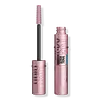By Terry Mascara Terrybly - Growth Booster Versus Maybelline Lash Sensational Sky High Waterproof Mascara
What's inside
What's inside
 Key Ingredients
Key Ingredients

 Benefits
Benefits

 Concerns
Concerns

 Ingredients Side-by-side
Ingredients Side-by-side

Water
Skin ConditioningCandelilla Cera
EmollientAcacia Decurrens/Jojoba/Sunflower Seed Wax Polyglyceryl-3 Esters
EmollientCI 77499
Cosmetic ColorantCopernicia Cerifera Cera
EmollientPPG-25-Laureth-25
EmulsifyingGlycerin
HumectantStyrene/Acrylates/Ammonium Methacrylate Copolymer
Potassium Cetyl Phosphate
EmulsifyingSteareth-21
CleansingAlcohol Denat.
AntimicrobialAcacia Senegal Gum
MaskingButylene Glycol
HumectantCetyl Alcohol
EmollientSilica
AbrasiveSimethicone
EmollientSteareth-2
EmulsifyingPhenoxyethanol
PreservativeHydroxyethylcellulose
Emulsion StabilisingImidazolidinyl Urea
PreservativePropylene Glycol
HumectantMica
Cosmetic ColorantEthylparaben
PreservativeMethylparaben
PreservativeTetrasodium EDTA
Propylparaben
PreservativeDipotassium Phosphate
BufferingSodium Hyaluronate
HumectantPentaerythrityl Tetraisostearate
EmollientGlycoproteins
Skin ConditioningTriethoxycaprylylsilane
Silica Dimethyl Silylate
EmollientBiotin
AntiseborrhoeicSodium Chondroitin Sulfate
Skin ConditioningAtelocollagen
Skin ConditioningWater, Candelilla Cera, Acacia Decurrens/Jojoba/Sunflower Seed Wax Polyglyceryl-3 Esters, CI 77499, Copernicia Cerifera Cera, PPG-25-Laureth-25, Glycerin, Styrene/Acrylates/Ammonium Methacrylate Copolymer, Potassium Cetyl Phosphate, Steareth-21, Alcohol Denat., Acacia Senegal Gum, Butylene Glycol, Cetyl Alcohol, Silica, Simethicone, Steareth-2, Phenoxyethanol, Hydroxyethylcellulose, Imidazolidinyl Urea, Propylene Glycol, Mica, Ethylparaben, Methylparaben, Tetrasodium EDTA, Propylparaben, Dipotassium Phosphate, Sodium Hyaluronate, Pentaerythrityl Tetraisostearate, Glycoproteins, Triethoxycaprylylsilane, Silica Dimethyl Silylate, Biotin, Sodium Chondroitin Sulfate, Atelocollagen
Isododecane
EmollientCera Alba
EmollientCopernicia Cerifera Cera
EmollientDisteardimonium Hectorite
StabilisingWater
Skin ConditioningAlcohol Denat.
AntimicrobialAllyl Stearate/Va Copolymer
Oryza Sativa Cera
Skin ConditioningParaffin
PerfumingPolyvinyl Laurate
Vp/Eicosene Copolymer
Propylene Carbonate
SolventTalc
AbrasiveSynthetic Beeswax
Emulsion StabilisingEthylenediamine/Stearyl Dimer Dilinoleate Copolymer
Skin ConditioningPEG-30 Glyceryl Stearate
EmulsifyingRayon
Hydrogenated Jojoba Oil
AbrasiveCaprylic/Capric Triglyceride
MaskingSilica
AbrasivePentaerythrityl Tetra-Di-T-Butyl Hydroxyhydrocinnamate
AntioxidantBambusa Vulgaris Extract
Skin ConditioningBHT
AntioxidantCI 77491
Cosmetic ColorantCI 77492
Cosmetic ColorantCI 77499
Cosmetic ColorantCI 77007
Cosmetic ColorantMica
Cosmetic ColorantCI 77891
Cosmetic ColorantCI 75470
Cosmetic ColorantCI 77288
Cosmetic ColorantCI 77742
Cosmetic ColorantCI 77510
Cosmetic ColorantIsododecane, Cera Alba, Copernicia Cerifera Cera, Disteardimonium Hectorite, Water, Alcohol Denat., Allyl Stearate/Va Copolymer, Oryza Sativa Cera, Paraffin, Polyvinyl Laurate, Vp/Eicosene Copolymer, Propylene Carbonate, Talc, Synthetic Beeswax, Ethylenediamine/Stearyl Dimer Dilinoleate Copolymer, PEG-30 Glyceryl Stearate, Rayon, Hydrogenated Jojoba Oil, Caprylic/Capric Triglyceride, Silica, Pentaerythrityl Tetra-Di-T-Butyl Hydroxyhydrocinnamate, Bambusa Vulgaris Extract, BHT, CI 77491, CI 77492, CI 77499, CI 77007, Mica, CI 77891, CI 75470, CI 77288, CI 77742, CI 77510
 Reviews
Reviews

Ingredients Explained
These ingredients are found in both products.
Ingredients higher up in an ingredient list are typically present in a larger amount.
Alcohol Denat. is an alcohol with a denaturant property. It is created by mixing ethanol with other additives.
This ingredient gets a bad rep because it is irritating and drying - mostly due to its astringent property. Astringents draw out natural oils in tissue, constricting pores and leaving your skin dried out.
However, alcohol denat. is not all that bad.
Due to its low molecular weight, alcohol denat. tends to evaporate quickly. One study on pig skin found half of applied alcohol evaporated in 10 seconds and less than 3% stayed on skin.
This also helps other ingredients become better absorbed upon application.
Studies are conflicted about whether this ingredient causes skin dehydration. One study from 2005 found adding emollients to propanol-based sanitizer decreased skin dryness and irritation. Another study found irritation only occurs if your skin is already damaged.
Small amounts of alcohol are generally tolerated by oily skin or people who live in humid environments.
The rule of thumb is if this alcohol is near the end of an ingredients list, it will probably not affect your skin much.
Also...
This ingredient has antimicrobial and solvent properties.
The antimicrobial property helps preserve products and increase their shelf life. As a solvent, it helps dissolve other ingredients.
Other types of astringent alcohols include:
Learn more about Alcohol Denat.Ci 77499 is also hydrated iron III oxide. It is created from mixing red and black iron oxides. This helps give shades of darkness to a product.
Iron III oxides are classified as inorganic chemicals for coloring.
This ingredient comes from a palm tree native to Brazil. This ingredient is used to thicken texture and leaves behind a film when applied.
Mica is a naturally occurring mineral used to add shimmer and color in cosmetics. It can also help improve the texture of a product or give it an opaque, white/silver color.
Serecite is the name for very fine but ragged grains of mica.
This ingredient is often coated with metal oxides like titanium dioxide. Trace amounts of heavy metals may be found in mica, but these metals are not harmful in our personal products.
Mica has been used since prehistoric times throughout the world. Ancient Egyptian, Indian, Greek, Roman, Aztec, and Chinese civilizations have used mica.
Learn more about MicaSilica, also known as silicon dioxide, is a naturally occurring mineral. It is used as a fine, spherical, and porous powder in cosmetics.
Though it has exfoliant properties, the function of silica varies depending on the product.
The unique structure of silica enhances the spreadability and adds smoothness, making it a great texture enhancer.
It is also used as an active carrier, emulsifier, and mattifier due to its ability to absorb excess oil.
In some products, tiny microneedles called spicules are made from silica or hydrolyzed sponge. When you rub them in, they lightly polish away dead skin layers and enhance the penetration of active ingredients.
Learn more about SilicaWater. It's the most common cosmetic ingredient of all. You'll usually see it at the top of ingredient lists, meaning that it makes up the largest part of the product.
So why is it so popular? Water most often acts as a solvent - this means that it helps dissolve other ingredients into the formulation.
You'll also recognize water as that liquid we all need to stay alive. If you see this, drink a glass of water. Stay hydrated!
Learn more about Water